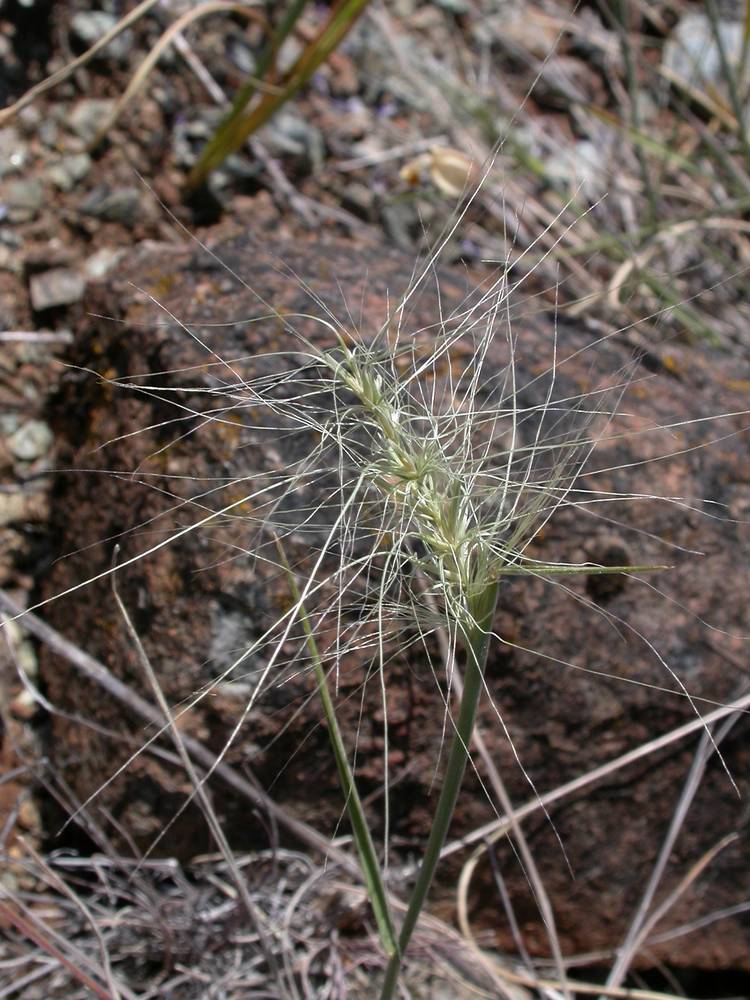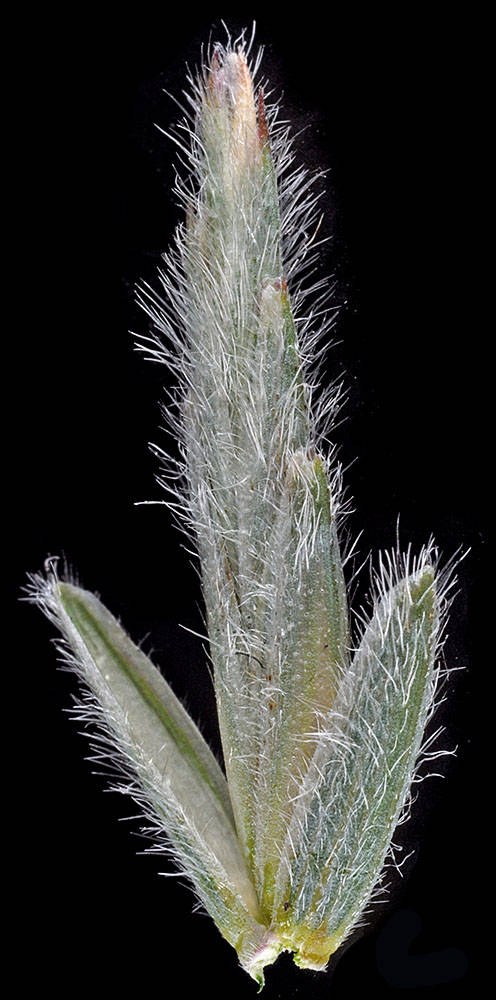Elymus multisetus
Elymus lanceolatus
big squirreltail
thickspike wheatgrass
erect to ascending.
erect.
sheaths glabrous or white-villous;
blades 1.5–4 mm wide;
upper surfaces scabrous or hairy.
sheaths glabrous or pubescent;
blades 1.5–6 mm wide;
outer surfaces usually glabrous;
inner surfaces with appressed hairs.
5–20 cm; erect, sometimes partially enclosed in the sheath of the uppermost leaf, 2 spikelets per node or rarely 3–4 at some nodes;
internodes 3–5(8)mm;
disarticulation initially at the rachis nodes; later beneath each floret.
3.5–26 cm; erect to slightly nodding, 1 spikelet per node but occasionally with 2 at a few nodes;
internodes 3.5–15 mm;
disarticulation above the glumes; beneath each floret.
10–15 mm, divergent, 2–4 florets; lowest florets sterile and glume-like in 1 or both spikelets at each node.
8–31 mm, 1.5–3 times longer than the internodes, appressed, 3–11 florets, glabrous or hairy;
hairs to 1 mm.
(10)30–100 mm including the awns; the bases hard and glabrous;
glume bodies about (2)5–10 × 1–2 mm, setaceous, 2–3-veined;
margins firm;
glume awns (8)25–90 mm; each split above the base into 3–9 unequal divisions, scabrous, flexuous to outcurving from near the bases at maturity.
5–14 mm, 50–75% the length of the adjacent lemmas, 0.7–1.3 mm wide, lanceolate, glabrous or hairy; smooth or scabrous, 3–5-veined; flat or weakly keeled;
keels straight;
margins narrow, tapering from the base or from beyond mid-length;
tips acute to acuminate, sometimes mucronate or short-awned.
fertile lemmas 8–10 mm; smooth or scabrous near the tips, 2 lateral veins extending into bristles to 10 mm;
lemma awns (10)20– 110 × 0.2 mm at the base, divergent to arching.
7–12 mm, glabrous to densely long-hairy; all hairs similar, sometimes scabrous;
tips acute to awned;
lemma awns; if present; to 2 mm; straight.
1–2 mm.
2.5–6 mm.
=28.
Elymus multisetus
Elymus lanceolatus
Dry, often rocky grasslands and savannas. 50–2000m. BR, Col, ECas, Lava, Sisk, WV. CA, ID, NV, WA; southeast to CO, south to Mexico. Native.
Elymus multisetus has inflorescences that fall apart at maturity and glumes that are divided into three to nine widely spreading awns. Very similar E. elymoides has glumes that are entire or unevenly split into two to three parts. Determining how much the glumes are split is complicated by the presence of glumelike sterile lemmas in both E. multisetus and some E. elymoides subspecies. Elymus multisetus glumes are divided above the base. If the glumes appear to be divided to the base, the plant is more likely to be E. elymoides.
3 subspecies.
Elymus lanceolatus is a strongly rhizomatous wheatgrass that lacks or nearly lacks awns. It is most similar to Pascopyrum smithii, which has more basally concentrated leaves and glumes that taper from near the base and have curved midveins. It is also similar to E. trachycaulus, which is cespitose, has consistently glabrous lemmas, and has glumes 75–100% as long as the lemmas.
Barbara Wilson, Richard Brainerd, Nick Otting
Barbara Wilson, Richard Brainerd, Nick Otting
- Local floras:
CA,
OR,
WA
- Local Web sites:
CalFlora,
CalPhotos,
Flora NW,
PNW Herbaria
WildflowerSearch
iNaturalist (observations)
USDA Plants Database
- LBJ Wildflower Center
- SEINet
- Plants of the World Online
- Encyclopedia of Life
- Wikipedia
- Google Image Search
- Local floras:
BC,
OR,
WA
- Local Web sites:
Flora NW,
PNW Herbaria
WildflowerSearch
iNaturalist (observations)
USDA Plants Database
- LBJ Wildflower Center
- SEINet
- Plants of the World Online
- Encyclopedia of Life
- Wikipedia
- Google Image Search





